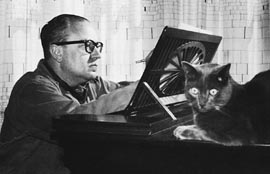Alberto Ginastera (1916-1983)
Born April 11, 1916 in Buenos Aires.
Died June 25, 1983 in Geneva.
Variaciones concertantes, Op. 23
Composed: 1953.
First Performance: June 2, 1953 in Buenos Aires with Igor Markevitch conducting the Asociacion de la Musica Orchestra.
Instrumentation: piccolo, 2 flutes, oboe, 2 clarinets, bassoon, 2 horns, trumpet trombone, timpani, harp, strings.
Duration: ~ 24 min.
Alberto Ginastera was a gifted young musician who began piano study at age 7, entered a preparatory conservatory at age 12, and graduated from the National Conservatory of Music in Buenos Aires in 1938. In the mid 1940s a Guggenheim Fellowship enabled him to study in the United States, notably with Aaron Copland at Tanglewood. The political situation in Argentina in 1968 forced him to leave his homeland. He taught at Dartmouth College before finally moving to Switzerland in 1971.
Ginastera himself grouped his music into three distinct periods. In the 1930s-1940s he used Argentine folk materials directly. His ballet Panambí, Op. 1 (1934-1936) falls into this category. He believed that “Any work of talent, as has always happened in the history of the arts, is in the final analysis ‘national’.’” In his next stylistic period during the 1950s, he no longer directly quoted folk sources. Like Copland and Bartók before him he had assimilated elements of folk music to produce something more personal. Today’s work, the Variaciones Concertantes, belongs to this period. In the late 1950s his style evolved again involving the use of serial techniques. There is a parallel between Ginastera and Copland. Both composers’ early works began with a style rooted in national sources (In Copland’s case Billy the Kid, Rodeo, etc.) which gradually evolved towards serialism but both became and remained well known and loved national figures.
The Variaciones Concertantes was commissioned by the Asociacion Amigos de la Musica of Buenos Aires (Argentine Friends of Music) in 1953. It was premiered the same year. In regard to the Variaciones Concertantes Ginastera wrote: “These variations have a subjective Argentine character. Instead of using folkloristic material, I try to achieve an Argentine atmosphere through the employment of my own thematic and rhythmic elements. The work begins with an original theme followed by eleven variations, each one reflecting the distinctive character of the instrument featured. All the instruments of the orchestra are treated soloistically. Some variations belong to the decorative, ornamental or elaborative type, others are written in the contemporary manner of metamorphosis, which consists of taking elements of the main theme and evolving from it new material.”
The movements, played without interruption, are:
1. Theme for cello and harp (Adagio molto espressivo)
2. Interlude for strings (same tempo)
3. Variazone giocosa for flute (Tempo giusto)
4. Variazone in modo di scherzo for clarinet (Vivace)
5. Variazone drammatica for viola (Largo).
6. Variazone canonica for oboe and bassoon (Adagio tranquillo)
7. Variazone ritmica for trumpet and trombone (Allegro)
8. Variazone in modo di moto perpetuo for violin (same tempo)
9. Variazone pastorale for French horn (Largamente)
10. Interlude for winds (Moderato)
11. Reprise of theme for double bass (Adagio molto espressivo)
12. Final variation in rondo form for orchestra (Allegro molto)
Some of the elements of his national style come from gauchesco music; the music of the gauchos, the landless native horseman of the plains who are sometimes compared to cowboys. One example is the Malambo. The Malambo dance form originated on the Argentine Pampas during the 17th century. It is similar to the Spanish Flamenco but is danced solely by men. This rhythmic dance alternates between energetic tapping with the feet (zapateo) and grazing the floor with the sole of the foot (cepillada). It is performed by a solo gaucho who challenges other gauchos to see who makes better moves. In 1940 he composed the piano work Malambo Op. 7 which starts by imitating the gaucho’s main instrument – the guitar. The piano plays a slow arpeggio on the first guitar chord everyone learns: the open strings (E-A-D-G-B-E). It then launches into a frenetic moto perpetuo dance. Movements 4 (clarinet), 7 (trumpet and trombone), and the finale of the Variaciones Concertantes are based on the malambo.
The first movement – the theme for Cello and Harp begins the Variaciones Concertantes in the same way. Here the harp starts with the guitar chord arpeggio. The cello plays the plaintive theme while the harp varies the opening chord. The guitar chord contains an E minor chord (with some extra bits) but this movement alternates between E minor and major. This bitonality recurs throughout the work but especially in movements 9 and 10. Movement 6 is based on the harmony rather than the melody and is in two parts. Movement 8 is a simple ABA form. The aggressive energy of the malambo returns for the finale to bring the work to an exciting conclusion.
Early in Ginastera’s career Aaron Copland wrote that “No account of music in the Argentine is complete without mention of his name.” Copland’s assessment of Ginastera’s achievement is still true.
Resources
[amazon template=iframe image&asin=B000001SFI][amazon template=iframe image&asin=B000IY063E][amazon template=iframe image&asin=B00005LC3C]
[amazon template=iframe image&asin=B005ABFAA4]
